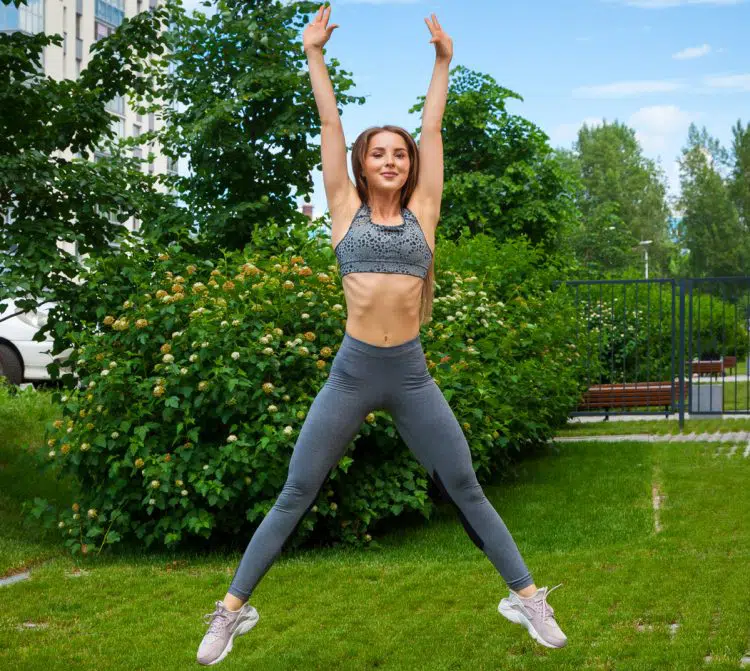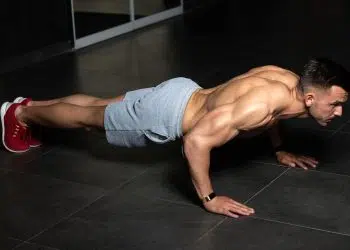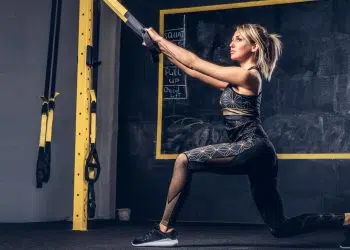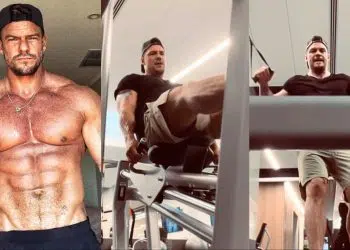Working out can be time-consuming. And, for many people, getting to the gym takes longer than their actual exercise session. That may be unavoidable if you are planning on lifting weights or using equipment that you don’t have at home. But, if you just want to do some cardio, going to the gym could be unnecessary.
To get a good cardio workout, all you need to do is move your body, doing exercises like burpees, box jumps, jump rope, or running. While things like stationary bikes, rowing machines, ellipticals, and treadmills are NICE to use, they are far from essential.
Whether you do circuit training or HIIT, you can develop a high level of cardiovascular fitness and burn calories doing nothing but bodyweight exercises.
In this guide, we explain why and how to do star jumps and provide you with some useful variations and alternatives.
Star Jumps – Muscles Worked
Star jumps are very much a full-body exercise. That’s why they are so effective and demanding. To supply your muscles with oxygenated blood, your heart and breathing rate speed up, which delivers a beneficial cardiovascular workout.
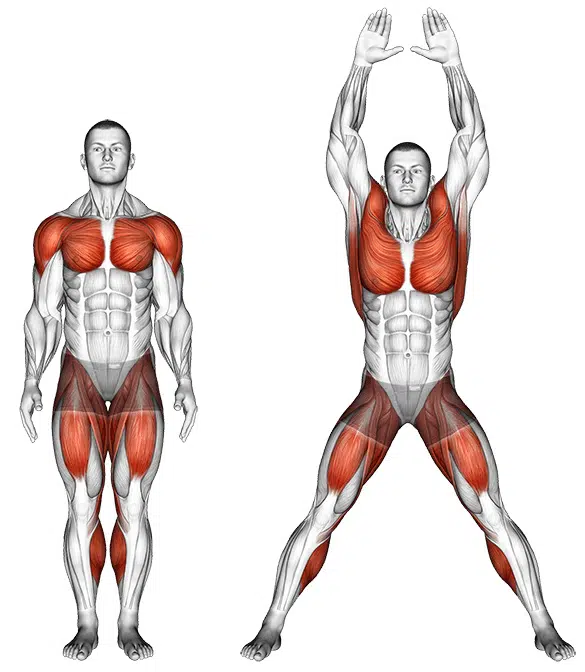
That said, star jumps really target the following muscles:
Level Up Your Fitness: Join our 💪 strong community in Fitness Volt Newsletter. Get daily inspiration, expert-backed workouts, nutrition tips, the latest in strength sports, and the support you need to reach your goals. Subscribe for free!
Quadriceps
Known as the quads for short, these are the muscles on the front of your thighs. They are responsible for extending your knees, and you’ll feel them working hard during star jumps. The four quadriceps are rectus femoris, and vastus lateralis, medialis, and intermedius.
Gluteus maximus
Your gluteus maximus, better known as your glutes, is basically your butt. Its primary function is the extension of your hips. Star jumps involve a deep squat, which gives the glutes a serious workout.
Hip abductors
Driving your legs outward as you jump into the air uses your hip abductors. Consisting of the gluteus minimus and medius and tensor fascia latae, these muscles are located on the outside of your hips.
Hamstrings
Working with your glutes, your hamstrings extend your hips during star jumps. Located on the back of your thigh, the three hamstring muscles are the biceps femoris, semimembranosus, and semitendinosus. The hamstrings also flex your knees, e.g., during leg curls.
Triceps surae
This is the collective name for the two muscles of your calves; the gastrocnemius and soleus. These muscles work together to plantarflex your ankle, and gastrocnemius is also involved in knee flexion.
Core
These are the muscles that make up your midsection, namely the rectus abdominis, obliques, transverse abdominis, and erector spinae. Your core stabilizes your spine during star jumps.
Deltoids
Lifting your arms up and out to the side engages your deltoids or shoulder muscles. There are three deltoid heads; anterior (front), posterior (rear), and medial (middle). While all three deltoid heads are involved in star jumps, the medial head is doing more of the work.
How to Do Star Jumps
Get more from star jumps while keeping your risk of injury to a minimum by following these guidelines. Star jumps are a high-impact exercise that are also pretty intense, so make sure you warm up before trying it.
- Stand with your feet about hip-width apart, arms by your sides. Pull your shoulders down and back and brace your core. Look straight ahead.
- Keeping your heels pressed into the floor, squat down and touch the tops of your feet. Try not to round your lower back excessively.
- Drive your feet into the floor and jump up into the air. Simultaneously open your legs and raise your arms above shoulder height to form an X shape.
- Quickly bring your feet back together and lower your arms before landing and descending into another rep. Land on slightly bent legs to absorb the impact.
Star Jump Benefits and Drawbacks
Not sold on star jumps yet? Consider these benefits:
Convenience
With no equipment required, you can do star jumps almost anywhere and anytime. While you could do them at the gym, nothing is stopping you from doing star jumps at home, backyard, or in your local park.
Scalable
Make star jumps easier or harder by altering your jump height. You can also make them less challenging simply by squatting less deeply. This makes star jumps suitable for most beginner, intermediate, and advanced exercisers.
Good for developing leg power
While most people do star jumps for their cardiovascular and calorie-burning effects, they’re also a great lower body power exercise. If you want more explosive legs, such as for sports or a bigger vertical jump, star jumps could help.
Easy to learn
Star jumps are a relatively straightforward exercise that most people can learn and master in minutes. This makes them ideal for group training situations, such as working out with a friend or circuit training classes.
While star jumps are a mostly beneficial exercise, there are also a few drawbacks to consider:
Level Up Your Fitness: Join our 💪 strong community in Fitness Volt Newsletter. Get daily inspiration, expert-backed workouts, nutrition tips, the latest in strength sports, and the support you need to reach your goals. Subscribe for free!
High-impact
What goes up must come down, and landing after a star jump involves a lot of impact. That impact is greater if you are muscular and heavy or just overweight. If you have foot, ankle, knee, hip, or lower back issues, star jumps may not be comfortable or safe. Reduce the impact by wearing shock-absorbing shoes, doing star jumps on an exercise mat, or on a more forgiving surface, such as grass.
Knee issues
In addition to the impact, the deep squat in star jumps could cause knee pain. That’s especially true if you have ligament or cartilage injuries. Skip star jumps if you have a history of knee pain.
Joint instability
If your knees tend to roll in or out during squats, that problem will probably be worse during star jumps. Unstable joints are more prone to injury. Give star jumps a miss if you suffer from joint instability.
7 Star Jump Variations and Alternatives
Star Jumps are a highly effective conditioning and lower body power exercise, but that doesn’t mean they’re suitable for everyone or that you should do them all the time. There are several variations and alternatives you can use to keep your workouts productive and interesting:
1. Squat jumps
If you find it hard to do star jumps, maybe because you can’t jump high enough to open and close your legs, try squat jumps. This exercise involves fewer movements but still works the same muscles as star jumps. You don’t need to squat as deep, either, so this may be a more knee-friendly variation.
How to do it:
- Stand with your feet about shoulder-width apart. Brace your core and pull your shoulders down and back.
- Squat down until your thighs are roughly parallel to the ground. Swing your arms behind you.
- Jump up and into the air, swinging your arms forward and overhead.
- Land on slightly bent knees and descend into another rep.
- You can also do squat jumps with dumbbells in your hands and arms by your sides or using a hex/trap bar. Alternatively, do squat jumps with a barbell on your upper back. However, these are all advanced variations.
Read more about squat jumps here.
2. Box jumps
The biggest downside of star jumps is the impact on landing. It can cause joint pain throughout your lower body, as well as your lower back. Box jumps eliminate a lot of that impact, making them much more joint-friendly.
How to it:
- Set up your box. It should be sturdy, stable, and won’t tip over. Start off with a box that’s about knee height or a little lower.
- Stand about one large step back from your box. Your feet should be around shoulder-width apart.
- Descend into a quarter-depth squat and swing your arms behind you.
- Without pausing, drive your feet into the floor, swing your arms forward, and jump up and onto your box.
- Land lightly on the top of your box, aiming your feet for the middle. Bend your legs to absorb the shock of your landing.
- Step back down, reset your starting position, and repeat.
Find out more about box jumps in our in-depth guide.
3. Burpees
Burpees, like star jumps, are a no-frills conditioning exercise you can do almost anywhere and anytime. But, as an added benefit, they also work your upper body, making them even more challenging and time-efficient.
While it’s true that no one likes doing burpees because they are such a challenging exercise, there is no denying their effectiveness!
How to do it:
- Stand with your feet together and your hands by your sides.
- Squat down and place your hands flat on the floor in front of your feet. Try not to round your lower back.
- Jump your feet out and back to land in the push-up position.
- Bend your arms and lower your chest to lightly touch the floor.
- Push back up to full arm extension.
- Jump your feet in and under your body, knees close to your elbows.
- Leap up into the air as high as you can.
- Land on slightly bent knees and then repeat, repeat, REPEAT!
Learn all there is to know about burpees here.
4. Jumping jacks
Jumping jacks are another convenient, equipment-free conditioning exercise. They involve considerably less impact, so they may be better than star jumps for some people. But, like star jumps, they’re an effective fitness exercise that you can do anywhere and anytime.
How to do it:
- Stand with your feet together and your hands by your sides.
- Jump your feet out to a little wider than shoulder-width apart while simultaneously lifting your arms out and arms above your head.
- Jump your feet back in and lower your arms.
- That’s one rep; keep going!
- If raising your arms above your head is too challenging, or causes shoulder pain, just lift your arms until they are parallel to the floor.
5. Lateral hurdle jumps
Jumping side to side increases hip abductor engagement and may also improve joint stability, agility, and balance. You don’t even need a hurdle to do this exercise; just imagine you are jumping over a low obstacle.
How to do it:
- Stand sideways onto a low hurdle, medicine ball, or barbell.
- Bend your knees and descend into a quarter-depth squat.
- Using your arms for extra momentum, jump sideways and over your obstacle.
- Without pausing, descend again and jump back over.
- Continue for the required duration or prescribed number of reps.
6. Jump rope
It’s tough to do more than a minute or so of star jumps. 20-30 seconds will probably be enough for most people. If you want a less intense but equally low-tech conditioning exercise, try jumping rope. A favorite of boxers and MMA fighters, jumping rope provides a great cardiovascular workout, but you should be able to do it for more than just a few reps.
Learn more about different jump rope techniques and workouts here.
7. Split jumps
Split jumps, also known as jumping lunges, work many of the same muscles as star jumps. However, using a split stance means your base of support is narrower, which should lead to improved balance. Like star jumps, this is a good exercise for both fitness and lower body power.
How to do it:
- Step forward and out into a lunge. Bend your back leg and lower your knee down to just above the floor.
- Jump up and into the air and switch legs so that, when you land, your legs are reversed. Use your arms for balance or extra lift as required.
- Descend into another rep and repeat.
Find out more about split jumps here.
Star Jumps – Wrapping Up
Working out for fitness and fat loss can often seem like complicated, expensive, and time-consuming pursuits. And while things like treadmills and assault bikes are useful training tools, they are not essential.
Bodyweight exercises such as star jumps, burpees, push-ups, and running can be every bit as effective as state-of-the-art training equipment, but they’re free to use. Bodyweight exercises also mean you can work out anywhere and at any time. That could save you time because you won’t need to travel to the gym.
There are hundreds of bodyweight conditioning exercises you can do, and star jumps are a worthy addition to your workout library. Be warned, though; they’re a lot tougher than they look!
Interested in measuring your progress? Check out our strength standards for Push Ups, Jumping Jack, Squat Jump, and more.

